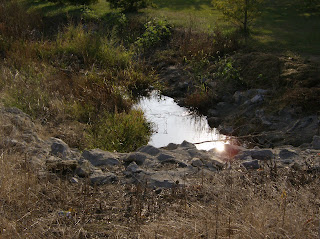
10/13/2007 6:59 AM
As I write this, I’m sitting in a cabin in the woods near Big Spring Missouri in the early morning hours, next to the fire I woke up and stoked up this morning. The cabin is unheated except for the fireplace, and although it is not midwinter or horribly cold outside, the fire does make the cabin much more hospitable.
As I woke up cold and decided to rekindle the fire, I knew I had to be quiet to allow my wife and brother to continue to sleep. So it was one of those early morning experiences where the silence magnifies every sound that does occur.
Through careful feeding of small sticks and nursing the reluctant coals back to life, I was able to get the fire going again. By the time I was feeding the big pieces in, I was ready for the warmth the fire would bring.
Then I noticed something. This was at a time when I had moved away from the fire and could not see it. There was a sound just like a geyser erupting. If it had not been for the recent trip to Yellowstone that my wife and I took this summer, I probably would not have made the association, but the sound of a branch violently offgassing was very similar to Old Faithful erupting. More on that later.
I moved closer to the fire and could hear more sounds coming out of it. Little high pitched notes, that I had trouble identifying at first. Morning twilight was starting, and the sun was starting to bring a tinge of light to the curtains. This is usually the time of morningsong, when the birds are waking up and start to sing joyously about how beautiful the new day is - at least that’s what I imagine. Maybe they are sharing sports scores or gossiping about the escapades of the night before. In this case, the fire was making those noises. I had never heard (or maybe just never noticed) such an uncanny duplication of the noise from a fire before. In the next 10 minutes, I noticed that the fire made a noise just like a steady strong wind, then it made a sound like a sail or cloth flexing in the wind. It also makes those really loud snaps, which are distinctly a sound from fire. Something about the early morning silence had focused my hearing and concentrated my imagination.
The geyser noises probably aren’t such a mystery, when you stop to consider them. I learned in Yellowstone, from reading the storyboards at various sights, how geysers work. If you think of the groundwater as a lake that has a surface under the ground, that’s a fair start. Rather than a clear surface of a lake you can see, the surface underground is bounded by rock and earth, so it is not as free to move as the skin of your favorite fishing lake. For a geyser to happen, you have to have the intense heat of the earth’s magma. I imagine a red hot arc of material that looks like a loop of your intestine, but I’m not sure how far away or what shape the magma takes. What is important is that it heats up the rocks below the ground, hotter than boiling water. At the beginning of an eruption cycle, this hot spot is underwater. The rock has some cracks, crevices, or holes that go all the way up to the surface, but the are filled with water. Just like your ears are under intense pressure at the bottom of a swimming pool, the water in contact with the hot spot is under pressure from all the water above it. Water under more pressure takes more heat to boil, so you can have superheated water in this region. At some point, the water gets so hot that it finally boils, and something starts the column of water moving upward. Once it starts to move upward, all the weight of the water above comes off the water below. Under pressure, this water was liquid, but without the pressure, the boiling point is quickly reached and the water turns to steam. Steam takes up much more volume that the water it came from, so it expands. This forces the column of water above, already in motion to shoot out of the mouth of the geyser with explosive force.
The sound is distinct, a prolonged rushing whooshing sound. If you’ve ever watched a fire, you’ve seen logs send out jets and streamers of flame. Something inside the log is suddenly trying to escape explosively. Wood is nothing more than a series of tubes, bundled together in a trunk, log, branch, or twig. In the living wood, the tubes carried water and nutrients from the ground to the leaves and back. The core of the tree is old conduits from earlier years, like a tree skeleton. The surface just below the bark is the active living part of the tree where the sap still flows. You cut a tree down and slice it up and stack it in a pile and all the sap that was in the tree doesn’t just pour out of the cut ends. In pine trees, there is some seepage of evaporated sap, or resin, on the ends, but most wood just magically dries up without leaking all the sap out. What happens? Probably two things. The water in the sap makes its way to the cut end and evaporates. In addition, some of it is probably converted into compounds in the resin. The resin eventually renders itself into a hard substance, like amber. That resin is distributed throughout the wood, and it is flammable. It is trapped in the inside of the wood, but under heat, it liquefies. When it finds an open channel to the surface, it boils from the release of pressure and it jets out of the opening, just like a geyser. Same process.
Discovering the mechanism behind the phenomena does nothing to diminish the lovely sound of the geysering wood.


















































